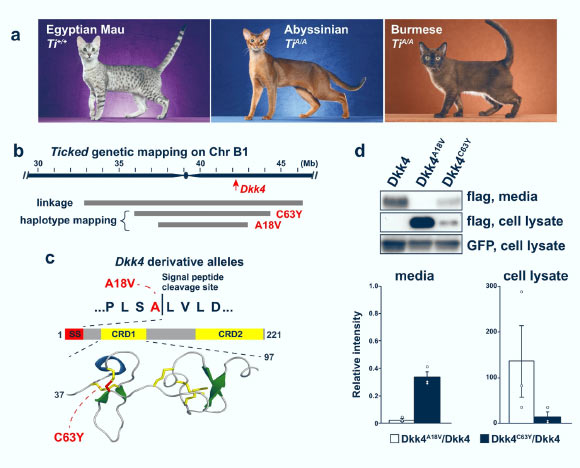New research shows that a signaling molecule encoded by a gene called Dickkopf 4 underlies a naturally occurring mutation that affects tabby patterns and plays a key role in the patterning process.
“Understanding the basis of the animal color pattern is a question of interest for developmental and evolutionary biology,” said Dr. Gregory Barsh and his colleagues from the HudsonAlpha Institute for Biotechnology and the Stanford University School of Medicine.
“In mammals, markings such as cheetah spots and tiger stripes helped motivate theoretical models that have the potential to explain how periodic and stable differences in gene expression and form might arise from a uniform field of identical cells.”
“Domestic cats are a useful model to study color patterns due to their accessibility, the genetic and genomic infrastructure, the opportunity for genomic and histological studies of tissue samples, and the diversity of pattern types,” they added.
“The archetypal tabby pattern — regularly spaced dark markings on an otherwise light background — varies considerably in both form and color, and many of those varieties are similar to some wild felid species.”
“In previous studies of domestic cats, we showed that the gene Endothelin 3 is expressed at the base of hair follicles in tabby markings, causes a darkening of the overlying hairs by increasing the production of black-brown eumelanin relative to red-yellow pheomelanin, and therefore plays a key role in the implementation of tabby pattern.”
“However, tabby markings are apparent in developing hair follicles, indicating that the establishment of the color patterns must occur at or before hair follicle development.”
In their new study, the researchers studied skin samples from non-viable cat embryos at different stages of development, and analyzed the genes of single cells and the proteins found in tissue sections.
They observed that differences in embryonic gene expression determine the shape of the color pattern produced later during hair growth.
They suggest that a signaling molecule encoded by the Dickkopf 4 gene plays a central role in this process and demonstrate that this gene is mutated in cats with ticked patterns such as Abyssinian or Servaline Savannah.
“Our results bring molecular understanding to how the leopard got its spots, suggest that similar mechanisms underlie periodic color pattern and periodic hair follicle spacing, and identify targets for diverse pattern variation in other mammals,” they said.
The results were published in the September 7, 2021 issue of the journal Nature Communications.
_____
C.B. Kaelin et al. 2021. Developmental genetics of color pattern establishment in cats. Nat Commun 12, 5127; doi: 10.1038/s41467-021-25348-2








